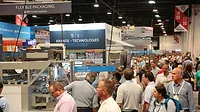ProFood Tech Preview
ProFood Tech Preview: Finding the right HPP solution
What processors need to know about evaluating HPP options

As high pressure processing offers processors more options, they need to keep in mind the variables that go into an effective HPP solution.
Photo courtesy of PMMI
According to Research Report Insights (RRI), a greater adoption of high pressure processing (HPP) solutions is a strong signal of a growing industry. Expectations for the sector’s growth are for an incremental dollar opportunity of $350.5 million during the report’s forecast period (2016-2026). In that span, the global HPP equipment market has a projected CAGR of 12.3 percent in terms of volume.
It’s no surprise that HPP is gaining favor among food processors. The FDA, USDA, Health Canada, European Union and several other authoritative regulator bodies recognize that it can increase shelf life and meet food safety standards without adding preservatives or altering flavor. This makes the technology especially appealing for applications in the ready-to-eat (RTE), fresh juice, dips and salsa, and shellfish categories. HPP can also streamline efficiency on the production line, providing energy and utility savings that help companies meet their sustainability goals. What’s not to like?
Before diving into an HPP installation, it is important for food and beverage processors to understand that these are not one-size-fits-all solutions. To help these companies maximize their investment, here are a few considerations to make.
Operation size: Small companies can reap the benefits of HPP, launching products into the marketplace quickly with the use of third-party service providers. These are independent companies with HPP facilities—essentially contract manufacturers—that sell time on their HPP equipment. For businesses just starting out, or those trying to make the transition into manufacturing from a retail environment, third parties are a great option.
Larger companies may be better equipped to advance their HPP processes with automation that can transform a traditional batch operation into a near-continuous one.
Testing: According to the Cold Pressure Council, HPP involves pressures between 100 and 600 MPa (megapascals). That’s a large range and brands must identify the right amount of pressure for the right amount of time for their products.
This level of precision requires testing to determine the optimal pressure/time solution. Companies can either work with third-party service providers or other experienced HPP solutions suppliers.
Integration: Creating HPP capabilities in-house requires not only significant capital investment, but also the necessary education for operators on the nuances of the technology. Food and beverage processors must work closely with equipment and packaging material suppliers to have all the proper protocols in place ahead of the installation. To maximize HPP’s potential boost to processors’ bottom lines, operators will benefit from a clear understanding of new protocols, thorough training and a foundation of experience using traditional equipment.
Get verified: Consider ways to educate consumers about your investment to provide preservative-free products that don’t sacrifice shelf life, flavor or quality. The Cold Pressure Council provides a pathway for brands to declare their products High Pressure Certified. Visit www.highpressurecertified.org to learn more.
Find the Right Solution at ProFood Tech
Look to ProFood Tech (March 26-28, 2019, McCormick Place, Chicago) as a resource for HPP solutions and insights. ProFood Tech is the only processing trade show in North America that addresses all market sectors, welcoming 7,000 professionals. Produced by PACK EXPO, Koelnmesse (organizer of Anuga) and the International Dairy Foods Association, the three-day event showcases cutting-edge crossover technologies and innovative solutions from 450 exhibitors over 150,000 net square feet of exhibit space. To register, visit profoodtech.com.
In conjunction, the Cold Pressure Council will hold its Annual Conference, March 26-27. Registration is open through ProFood Tech registration.
For more information, visit www.profoodtech.com
Looking for a reprint of this article?
From high-res PDFs to custom plaques, order your copy today!






